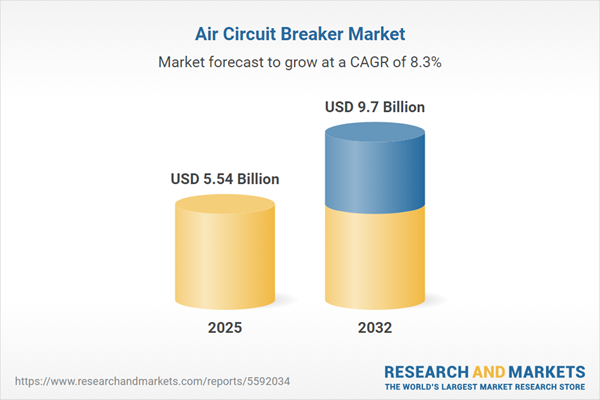Speak directly to the analyst to clarify any post sales queries you may have.
The air circuit breaker market is progressing rapidly, shaped by modernization in global power infrastructure and increasing requirements for safety and operational efficiency. Senior decision-makers must be aware of evolving technologies, new regulations, and the implications of shifting supply chain dynamics within this vital sector.
Market Snapshot: Air Circuit Breaker Market Growth and Drivers
The air circuit breaker market grew from USD 5.11 billion in 2024 to USD 5.54 billion in 2025. It is expected to continue growing at a CAGR of 8.33%, reaching USD 9.70 billion by 2032. Primary drivers include the digitalization of power infrastructure and expanded demand from data centers, industrial facilities, and utilities. Innovation in arc protection, increased integration with building and energy management systems, and sustainability mandates are further accelerating adoption and shaping competitive strategies for market participants.
Scope & Segmentation: Understanding the Market Landscape
- End-Use Industries: Commercial buildings, data centers, industrial facilities, mining operations, and power utilities are major sectors demanding advanced air circuit breaker solutions for diverse applications ranging from critical infrastructure to heavy-duty operation.
- Installation Types: Solutions span indoor (floor-mounted, panel-mounted), and outdoor (free air, enclosed, under switchgear) environments, catering to both fixed and withdrawable system requirements.
- Trip Mechanisms: Offerings include electronic trip (DSP or microprocessor-based), magnetic only, and thermal magnetic units (bimetallic, solenoid magnetic), providing tailored protection across a variety of electrical systems.
- Voltage & Current Ratings: Products address low, medium, and high voltage ranges, supporting a spectrum of current ratings and ensuring compatibility from compact commercial use up to high-capacity utility applications.
- Pole Counts: Two-, three-, and four-pole designs provide phase isolation and flexible deployment across diverse distribution networks.
- Delivery Modes: Aftermarket (maintenance replacement, retrofit) and OEM (integrated, modular) channels serve both upgrades and new installations.
- Regional Coverage: Market dynamics are evaluated in the Americas (United States, Canada, Mexico, and Latin America), Europe, Middle East and Africa, and Asia-Pacific, reflecting both developed and emerging market priorities.
- Key Companies: Schneider Electric, ABB, Siemens, Eaton, GE, Mitsubishi Electric, Fuji Electric, LS Electric, Chint Group, and Hager Group are analyzed with regard to innovation, partnerships, and regional strategies.
Key Takeaways for Senior Decision-Makers
- Technological advancement has shifted air circuit breakers from manual, isolated units to digitally connected, intelligent protection devices, crucial for proactive maintenance and system resilience.
- Manufacturers are introducing modular architectures and eco-conscious materials to meet environmental goals, while enhancing operational flexibility and ease of integration within facility management systems.
- Sectors such as data centers demand high-precision circuit protection with minimal service interruption, whereas mining and heavy industry prioritize durability and robust environmental protection.
- Real-time monitoring and diagnostic capabilities are becoming standard, leveraging AI-driven analytics and edge computing to anticipate failures and optimize lifecycle management.
- Supply chain adjustments, including nearshoring and local partnerships, are being employed to respond to trade policy changes and reduce exposure to cross-border disruptions.
- Regional disparities in standards and regulatory expectations require tailored product compliance and support models to succeed in both developed and fast-growing markets.
Tariff Impact: Navigating Trade Shifts and Supply Chain Realignment
New tariff measures introduced by the United States in 2025 have driven up manufacturing costs through duties on components and finished breakers sourced internationally. These changes are prompting manufacturers to reassess procurement strategy—shifting production closer to key markets and pursuing regional partnerships. While such realignment aims to maintain product quality and lead times, it requires significant capital outlay and can temporarily disrupt established supply chains. End users are adjusting maintenance and procurement schedules to manage volatile pricing and contractual uncertainties stemming from ongoing trade negotiations.
Methodology & Data Sources
This research applies a rigorous methodology, incorporating interviews with industry executives and technical specialists, together with secondary data from white papers, regulatory reports, and relevant publications. Analytical tools such as data triangulation and scenario modeling ensure findings are robust, reliable, and actionable.
Why This Air Circuit Breaker Market Report Matters
- Delivers strategic insights on market trends, innovation, and competitive responses to emerging technologies, regulatory requirements, and sustainability initiatives.
- Supports informed investment, sourcing, and operational decisions by segmenting the market across industry, application, and geography.
- Enables stakeholders to benchmark performance, identify partnership opportunities, and anticipate environmental or trade-related changes affecting the sector.
Conclusion
The air circuit breaker market is evolving alongside industry needs for safety, intelligence, and sustainability. Stakeholders equipped with a nuanced understanding of technology trends, regional dynamics, and supply chain risks will be well positioned to capture growth and drive operational excellence.
Additional Product Information:
- Purchase of this report includes 1 year online access with quarterly updates.
- This report can be updated on request. Please contact our Customer Experience team using the Ask a Question widget on our website.
Table of Contents
3. Executive Summary
4. Market Overview
7. Cumulative Impact of Artificial Intelligence 2025
List of Figures
Samples

LOADING...
Companies Mentioned
The key companies profiled in this Air Circuit Breaker market report include:- Schneider Electric SE
- ABB Ltd
- Siemens AG
- Eaton Corporation plc
- General Electric Company
- Mitsubishi Electric Corporation
- Fuji Electric Co., Ltd.
- LS Electric Co., Ltd.
- Chint Group
- Hager Group
Table Information
| Report Attribute | Details |
|---|---|
| No. of Pages | 182 |
| Published | October 2025 |
| Forecast Period | 2025 - 2032 |
| Estimated Market Value ( USD | $ 5.54 Billion |
| Forecasted Market Value ( USD | $ 9.7 Billion |
| Compound Annual Growth Rate | 8.3% |
| Regions Covered | Global |
| No. of Companies Mentioned | 11 |









